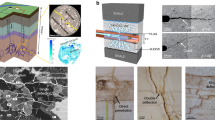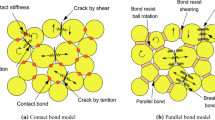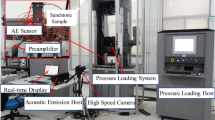Abstract
To study the fracture propagation mechanism and the permeability evolution of the fault fracture zone in coastal deep mines, the nuclear magnetic resonance (NMR) tests and the triaxial mechanical properties tests of rock specimens rock mass specimens with different joint dip angles under hydro-mechanical coupling were carried out. Based on the investigation of the surrounding rock joints and the analysis of rock composition, the rock physics experimental model was prepared. The evolution mechanism of rock porosity is obtained by NMR test. The changes of mechanical properties, acoustic emission (AE) and permeability characteristics of rock specimens with different joint dip angles were studied, and the evolution mechanism of permeability properties with different joint dip angles is revealed by combining the microstructure and joint tip expansion mechanism. When the jointed rock mass specimens reach the peak stress, the bearing capacity of the specimens decreases slowly, and the specimens show the characteristics of progressive failure. The specimen generates micro-cracks at the joint tip under the action of axial pressure, micro-cracks evolve and expand with the increase of pressure, the permeability coefficient gradually increases. The main fracture of jointed rock mass specimens is the fracture that originates from the joint tip and extends along the axial direction until the specimen loses its bearing capacity.
Highlights
-
Evolution mechanism of permeability properties was revealed.
-
The microstructure and joint tip expansion mechanism were studied.
-
The fracture propagation law of jointed rock mass specimens was investigated.














Similar content being viewed by others
References
Ardeshir A, Amiri M, Ghasemi Y et al (2014) Risk assessment of construction projects for water conveyance tunnels using fuzzy fault tree analysis. Inter J Civil Eng 12(4):396–412
Cai M (2016) Prediction and prevention of rockburst in metal mines–A case study of Sanshandao gold mine. J Rock Mech Geotech Eng 8(2):204–211
Castro R, Trueman R, Halim A (2007) A study of isolated draw zones in block caving mines by means of a large 3D physical model. Int J Rock Mech Min Sci 44(6):860–870
Cui G, Wei J, Feng XT et al (2019) Preliminary study on the feasibility of co-exploitation of coal and uranium. Int J Rock Mech Min Sci 123:104098
Gao R, Yan H, Ju F et al (2018) Influential factors and control of water inrush in a coal seam as the main aquifer. Int J Min Sci Technol 28(2):187–193
Golian M, Teshnizi ES, Nakhaei M (2018) Prediction of water inflow to mechanized tunnels during tunnel-boring-machine advance using numerical simulation. Hydrogeol J 26(8):2827–2851
Hassani H, Hloušek F, Alexandrakis C et al (2018) Migration-based microseismic event location in the Schlema-Alberoda mining area. Int J Rock Mech Min Sci 110:161–167
Khave GJ (2014) Delineating subterranean water conduits using hydraulic testing and machine performance parameters in TBM tunnel post-grouting. Int J Rock Mech Min Sci 70:308–317
LaMoreaux JW, Wu Q et al (2014) New development in theory and practice in mine water control in China. Carbon Evap 29(2):141–145
Lee H, Lee JW et al (2021) Permeability evaluation for artificial single rock fracture according to geometric aperture variation using electrical resistivity. J Rock Mech Geotech Eng 13(4):787–797
Li S, Liu R, Zhang Q et al (2016) Protection against water or mud inrush in tunnels by grouting: a review. J Rock Mech Geotech Eng 8(5):753–766
Li G, Meng Z, Wang X et al (2017) Hydrochemical prediction of mine water inrush at the Xinli Mine. China Mine Water Enviro 36(1):78–86
Liu Z, Dang W, He X (2012) Undersea safety mining of the large gold deposit in Xinli District of Sanshandao Gold Mine. Int J Miner Metall Mater 19(7):574–583
Ma D, Rezania M, Yu HS et al (2017) Variations of hydraulic properties of granular sandstones during water inrush: effect of small particle migration. Eng Geol 217:61–70
Małachowski K (2018) The biggest surface mining disaster in Poland and its economic results. Eur J Service Manag 28(4/2):247–255
Pappalardo G (2018) First results of infrared thermography applied to the evaluation of hydraulic conductivity in rock masses. Hydrogeol J 26(2):417–428
Polak K, Różkowski K, Czaja P (2016) Causes and effects of uncontrolled water inrush into a decommissioned mine shaft. Mine Water Environ 35(2):128–135
Ren C, Li B, Xu J et al (2020) A novel damage-based permeability model for coal in the compaction and fracturing process under different temperature conditions. Rock Mech Rock Eng 53(12):5697–5713
Shi L, Wang Y, Qiu M et al (2019) Assessment of water inrush risk based on the groundwater modeling system—a case study in the Jiaojia Gold Mine Area. China Arabian J Geosci 12(24):1–17
Song W, Liang Z (2021) Theoretical and numerical investigations on mining-induced fault activation and groundwater outburst of coal seam floor. Bull Eng Geol Env 80(7):5757–5758
Vaziri V, Khademi Hamidi J, Sayadi AR (2018) An integrated GIS-based approach for geohazards risk assessment in coal mines. Enviro Earth Sci 77(1):1–18
Wang SF, Li XB, Wang DM (2016) Mining-induced void distribution and application in the hydro-thermal investigation and control of an underground coal fire: A case study. Process Saf Environ Prot 102:734–756
Wang S, Li X, Wang S (2017) Separation and fracturing in overlying strata disturbed by longwall mining in a mineral deposit seam. Eng Geol 226:257–266
Wang SF, Li XB, Yao JR et al (2019) Experimental investigation of rock breakage by a conical pick and its application to non-explosive mechanized mining in deep hard rock. Int J Rock Mech Min Sci 12:104063
Wang J, Zhang Y, Qin Z et al (2020) Analysis method of water inrush for tunnels with damaged water-resisting rock mass based on finite element method-smooth particle hydrodynamics coupling. Comput Geotech 126:103725
Wolkersdorfer C, Nordstrom DK, Beckie RD et al (2020) Guidance for the integrated use of hydrological, geochemical, and isotopic tools in mining operations. Mine Water Environ 39(2):204–228
Wu J, Xu S, Zhou R et al (2016) Scenario analysis of mine water inrush hazard using Bayesian networks. Saf Sci 89:231–239
Wu N, Liang Z, Li Y et al (2019) Stress-dependent anisotropy index of strength and deformability of jointed rock mass: insights from a numerical study. Bull Eng Geol Env 78(8):5905–5917
Xue Y, Kong F, Qiu D et al (2020) The classifications of water and mud/rock inrush hazard: a review and update. Bull Eng Geol Env 11(2):221–321
Yan B, Guo Q, Ren F et al (2020a) Modified Nishihara model and experimental verification of deep rock mass under the water-rock interaction. Int J Rock Mech Min Sci 128:104250
Yan B, Ren F, Cai M et al (2020b) Bayesian model based on Markov chain Monte Carlo for identifying mine water sources in Submarine Gold Mining. J Clean Prod 253:120008
Yao B, Bai H, Zhang B (2012) Numerical simulation on the risk of roof water inrush in Wuyang Coal Mine. Int J Min Sci Technol 22(2):273–277
Yu J, Li H, Chen X (2013) Triaxial experimental study of associated permeability-deformation of sandstone under hydro-mechanical coupling. Chin J Rock Mech Eng 32(6):1203–1213
Zhang HQ, He YN, Tang CA et al (2009) Application of an improved flow-stress-damage model to the criticality assessment of water inrush in a mine: a case study. Rock Mech Rock Eng 42(6):911
Zhang SG, Liu JQ, Chen PP (2015) Experimental research on mechanical properties of granite under water-rock coupling. Chin J Rock Mech Eng 34(3):520–527
Zhou Q, Herrera J, Hidalgo A (2018) The numerical analysis of fault-induced mine water inrush using the extended finite element method and fracture mechanics. Mine Water Environ 37(1):185–195
Acknowledgements
This work is supported by China Postdoctoral Science Foundation (Grant No. 2021M701540).
Author information
Authors and Affiliations
Corresponding author
Ethics declarations
Conflict of interest
The authors declare that they have no known competing financial interests or personal relationships that could have appeared to influence the work reported in this paper.
Data availability
The data that support the findings of this study are available from the first and corresponding authors on reasonable request.
Additional information
Publisher's Note
Springer Nature remains neutral with regard to jurisdictional claims in published maps and institutional affiliations.
Rights and permissions
Springer Nature or its licensor (e.g. a society or other partner) holds exclusive rights to this article under a publishing agreement with the author(s) or other rightsholder(s); author self-archiving of the accepted manuscript version of this article is solely governed by the terms of such publishing agreement and applicable law.
About this article
Cite this article
Yan, B., Qi, Q., Liu, J. et al. Fracture propagation and permeability evolution mechanism of jointed rock mass in coastal mines. Rock Mech Rock Eng 56, 2763–2778 (2023). https://doi.org/10.1007/s00603-022-03193-z
Received:
Accepted:
Published:
Issue Date:
DOI: https://doi.org/10.1007/s00603-022-03193-z




